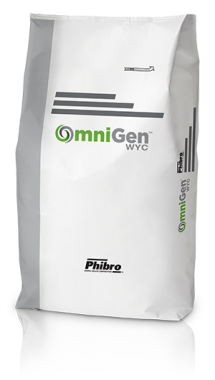Stop Heat Stress from Draining Your Profits (Q&A)
How Feeding OmniGen® Can Bolster Your Dairy Cattle’s Immune System to Better Defend Against Challenges.

Rumen fermentation and lactation generate high metabolic heat, making dairy cows particularly sensitive to heat stress whenever the temperature humidity index (THI) exceeds 68. Heat stress can affect cows’ milk production, reproduction and health, and it costs the average U.S. dairy farmer an average of $264 per cow1 per year. It’s no wonder that heat stress is a popular research topic.
As the Harriet B. Weeks professor in the Department of Animal Sciences, University of Florida, Dr. Geoff Dahl has led numerous studies examining the effects of heat stress on dairy cows at all phases of production. He recently teamed up with Dr. Glenn Holub, Executive Dairy Technology Manager, at Phibro Animal Health Corporation to host a free webinar titled Dairy’s Most Profit-Draining Challenges—Heat Stress, now available on demand from Phibro Academy. Dr. Dahl answered some common questions about dairy cattle heat stress.
Q&A with Dairy Cattle Heat Stress Expert, Dr. Geoff Dahl
What should producers look for as potential early signs of heat stress?
A: The first sign of heat stress is typically that lactating cows, and all cows, are going to have decreased dry matter intake (DMI). We know how important DMI is to maintaining milk yield—when DMI decreases, so does milk yield. What’s interesting, though, is that the reduction in milk yield is really beyond what we might expect based on decreased DMI. What’s happening is those cows must use additional energy to get rid of that extra heat—so that’s energy that is not available for milk production purposes.
How significantly can heat stress affect milk yield, according to your research?
A: We conducted a study that consistently showed the effects of heat stress on a cow’s next lactation compared to the milk production of cows that were cooled when they were dry or cows that were heat stressed when they were dry. This and other studies indicated we are looking at about an 8 to 10 lb per day reduction in milk yield if cows are heat stressed during the final phases of gestation during the dry period versus those animals that are cooled. It’s not just the one study that shows this, but a number of studies show the same thing. Cooled cows make more milk in the next lactation than cows that are heat stressed when they are dry. Heat stress has a profound and consistent effect on production. One reason for this is that we do see differences in various aspects of mammary development. We know that the dry period is important not only to have a reduction in older, less productive cells in the mammary gland, but also to regenerate capacity for milk yield in that next lactation. When we look at mammary cells, we see that the structure of mammary gland cells is different in heat stressed dry cows versus cows that are cooled during the dry period.
You’ve conducted a wealth of research examining the implications of heat stress. What have you seen recently in terms of the effects of heat stress on dry cows?
A: We conducted a study looking at aspects of animals seasonally being heat stressed when dry. We studied more than 1,500 dairy cows in Florida on one farm that had consistent, high-level management but were housed on pasture when dry during June, July and August—the hottest months of the year. We compared this group with another 1,000 cows that were housed on pasture when dry during the cooler months of the year—December, January and February. We saw about 1,100 pounds less milk in the next lactation in those cows that were dry during the hotter months of the year. Drying the cows in cool months improved performance. There is also definitely an effect on disease incidence in animals if they experience heat stress when they’re dry. Cows that were dry in hotter months ended up having increased rates of mastitis, respiratory disease and retained fetal membranes. Reproduction was also negatively affected in the cows that were dry in the hotter months.
Do I have to cool cows throughout the entire dry period?
A: We set up a “switch-back study” to determine when we need to start cooling and whether we can just wait to cool cows during the close-up phase. Cows were either cooled from the time they dried off until calving or heat stressed, and then halfway through the period, we switched half of those groups—so we ended up with cows that were either cooled for the entire dry period or cows that were heat stressed for the entire dry period, as well as cows that were cooled and then switched to heat stress and cows that were heat stressed and then cooled. Our results showed that no, you cannot just cool them during the close-up phase. It didn’t matter when the cows were stressed in the dry period; whether it was early or late, they all responded the same way as the cows that were heat stressed for the entire dry period. All heat-stressed cows made less milk than cows that were cooled for the entire time. We need to get cows cooled from the initiation of the dry period.
What are the effects of heat stress on the developing fetus?
A: We see significant effects of heat stress on the fetus that’s developing within that animal. While we tend to look at the effect on the cow as sort of programming her for less milk yield in that next lactation, the effects on the fetus program it for lower productivity and lower survivability in the herd. So, it’s a lifetime effect. In fact, the effects on the fetus may be even greater, when we look at them in aggregate, than the effects on the cow herself in the next lactation.
What has your research shown about the effects of feeding OmniGen® to cows that are heat stressed?
A: We looked at cows that were heat stressed from the time they were dried off until calving versus cows that were cooled for the entire dry period, and we fed OmniGen (or did not feed OmniGen to our control group) late in lactation and continued those treatments during the dry period. We continued those OmniGen treatments into lactation. Cows that were heat stressed and fed OmniGen during the dry period performed better once they freshened than those that were heat stressed and not fed OmniGen during the dry period. That suggests there is some benefit to feeding OmniGen. We also saw a reduction in respiration rates and rectal temperatures—which was similar to research responses done with heat stress cows—in the cows fed OmniGen.
What factors determine how a cow recovers from heat stress?
A: The severity and duration of the heat stress and the stage of lactation affect how a cow responds to and recovers from heat stress. Based on our data, it seems like cows that are further along in lactation may be more profoundly affected long term from heat stress than animals that are early in lactation. And certainly, cows that are dry are going to be profoundly impacted by heat stress. So, it’s really a combination of how severe that heat stress is, how long it has persisted, and what physiologic stage the animal is in. All these factors determine how much of a recovery the animal will be able to make, if any, from heat stress.
What surprises people the most about heat stress?
A: People are always surprised how much time of the year, and where, heat stress poses an issue. Really the only state where you don’t have to worry about heat stress is Alaska, but there obviously aren’t a lot of cows there either. Places that always tend to surprise people are the upper Midwest or the Northeast in terms of how much time of the year they experience heat stress. On average, across the top dairy states in the U.S., we’ve got about three months of heat stress each year, defined by an average THI for the day being greater than 68. This means that for at least a quarter of the year, animals are potentially heat stressed. And it’s not just in southern states like Florida or Arizona. There’s also significant potential impact of dry period heat stress in places like Indiana, Pennsylvania and even Michigan and Wisconsin. That’s a lot of unrecognized heat stress.
Reference:
1 Key et al., 2014. Climate Change, Heat stress and U.S. Dairy Production, Rep. No. 175.
OG210322GLB-E-R0122 ©2022 Phibro Animal Health Corporation. Phibro, Phibro logo design, Healthy Animals. Healthy Food. Healthy World. and OmniGen are trademarks owned by or licensed to Phibro Animal Health Corporation or its affiliates.
Dairy Cattle Products
How Feeding OmniGen® Can Bolster Your Dairy Cattle’s Immune System to Better Defend Against Challenges.





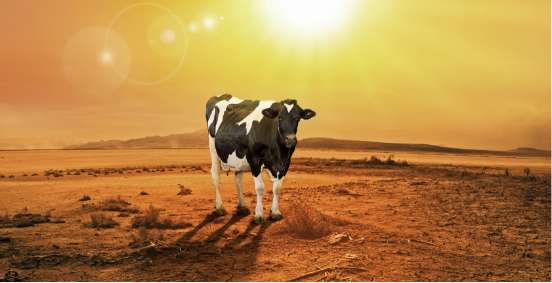
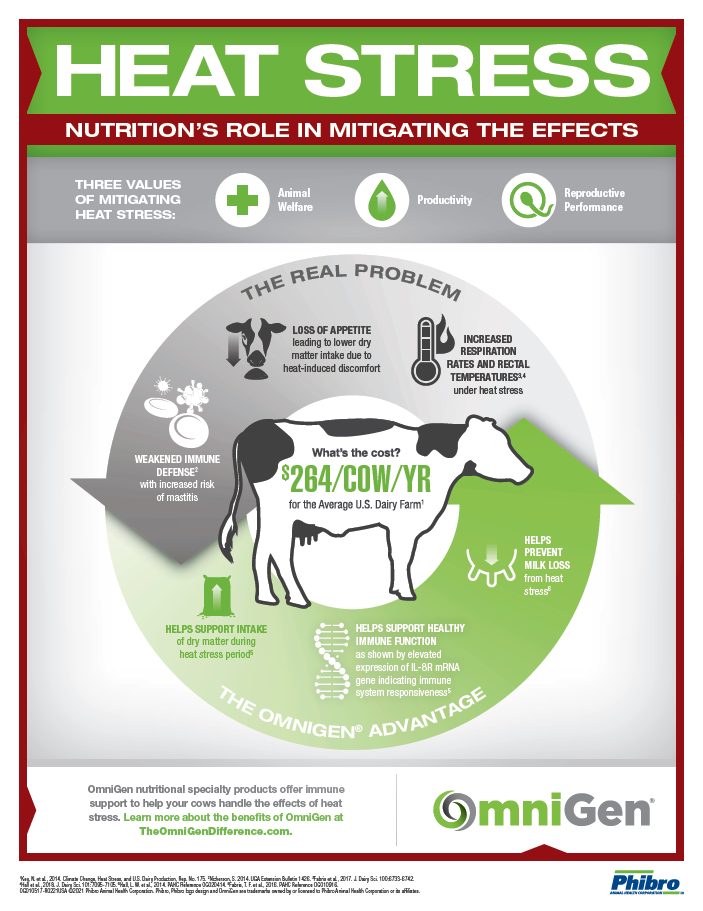
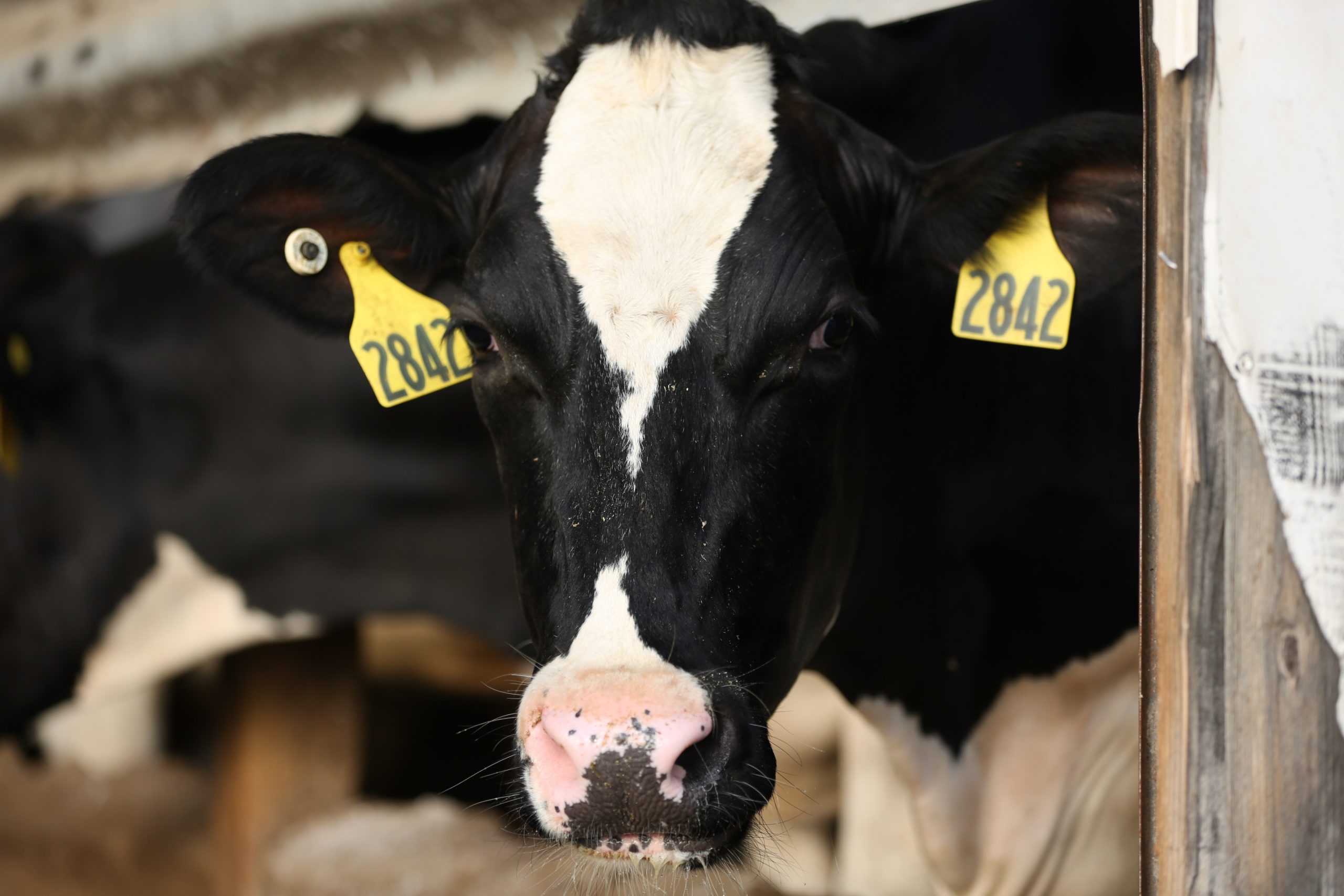
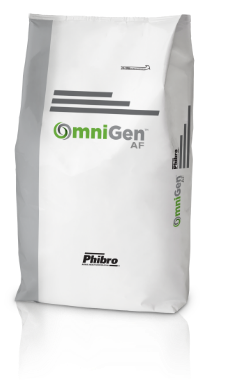
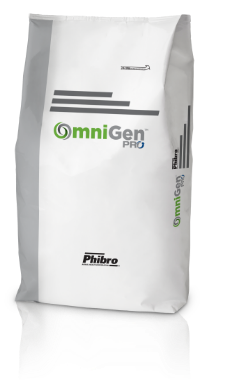
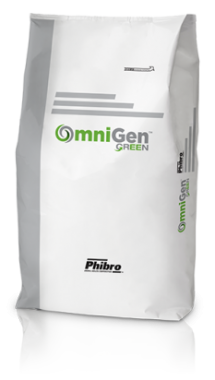
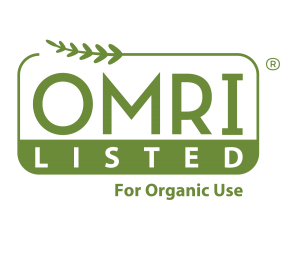 OmniGen Green is Organic Material Review Institute (OMRI) listed.
OmniGen Green is Organic Material Review Institute (OMRI) listed.